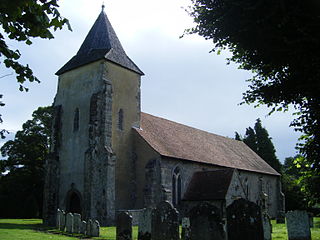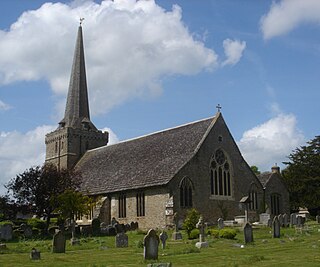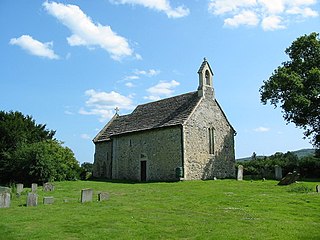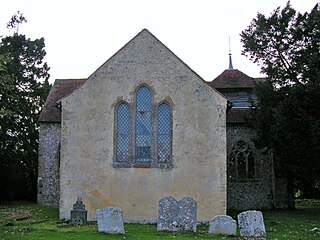Rudgwick is a village and civil parish in the Horsham District of West Sussex, England. The village is 6 miles (10 km) west from Horsham on the north side of the A281 road. The parish's northern boundary forms part of the county boundary between Surrey and West Sussex.

Tisman's Common is a hamlet in the Horsham District of West Sussex, England. It stands in the parish of Rudgwick, on the Rudgwick to Loxwood road, 6.4 miles (10.2 km) west of Horsham.

St Peter's Church is an Anglican church in the West Blatchington area of Hove, part of the English city of Brighton and Hove. Although it has 11th- and 12th-century origins, the church was rebuilt from a ruined state in the late 19th century and extended substantially in the 1960s, and little trace remains of the ancient building. The church serves the parish of West Blatchington, a residential area in the north of Hove near the border with Brighton.

St Peter's Church is a former Anglican church in the Preston Village area of Brighton, in the English city of Brighton and Hove. The 13th-century building, standing on the site of two older churches, was restored in the late 19th century and again after a serious fire in 1906. It was the parish church of Preston until 1908, when the newly built St John the Evangelist's Church gained this status. The Diocese of Chichester declared St Peter's redundant in 1990, and it is now owned by the Churches Conservation Trust. It has Grade II* listed status, reflecting its architectural and historical importance.

St. George's Church is an Anglican church in Trotton, a village in the district of Chichester, one of seven local government districts in the English county of West Sussex. Most of the structure was built in the early 14th century. However, some parts date to around 1230, and there is evidence suggesting an earlier church on the same site. In 1904, a largely intact and unusually detailed painting was found on the west wall depicting the Last Judgment as described in Matthew 25:31–46.

Holy Trinity Church is an Anglican church in the village of Cuckfield in the district of Mid Sussex; one of seven local government districts in the English county of West Sussex. It was founded in the 11th century and was in the possession of Lewes Priory by 1090. The present structure dates from the mid-13th century but was extended in the 14th century and heavily altered and restored during the Victorian period, with much interior work by Charles Eamer Kempe and stained glass by both Kempe and the Clayton and Bell firm. The church's spire was replaced in 1981 following a fire. Former chapels of ease in outlying hamlets have closed, and the church now serves a large rural area in the centre of Sussex. It is protected as a Grade I listed building.

St Mary's Church is an Anglican church in the village of Slaugham in Mid Sussex, one of seven local government districts in the English county of West Sussex. The 12th- and 13th-century church, restored in the Victorian era, serves a large rural area of the Sussex Weald, covering three villages as well as the ancient settlement of Slaugham. It also controlled the church in the market town of Crawley—now one of the area's largest towns—for the first few centuries of its existence. A locally important family built a private chapel in the church in the 17th century, and a series of memorials to deceased family members are considered to be excellent examples of their type. English Heritage has listed the building at Grade II* for its architectural and historical importance.

All Saints Church is an Anglican church in the hamlet of Buncton in the district of Horsham, one of seven local government districts in the English county of West Sussex. Built in the 11th or 12th century as a small chapel of ease to a nearby parish church, and hardly changed or restored since, the stone chapel stands behind a "delightful ... wooded ravine" beneath the South Downs and has been called "a real piece of hidden Sussex". The chancel arch, between the nave and chancel which made up the simple two-room building, had a bizarre 12th-century carving of a person of indeterminate sex exposing their genitalia—until 2004, when an unknown vandal destroyed it with a chisel. The church is still used for Christian worship, and English Heritage has listed it at Grade I for its architectural and historical importance. The church is also known as Buncton Chapel.

All Saints Church is the Anglican parish church of Roffey, in the Horsham district of the English county of West Sussex. The present church, built to serve the Victorian suburb of Roffey—part of the ancient market town of Horsham—replaced a schoolroom in which religious services had been held since 1856. Arthur Blomfield's Early English-style church, built of locally quarried sandstone and funded by a widow as a memorial to her late husband, was completed in 1878 and was allocated a parish immediately. Roman Catholic services were also held in the building to serve Roffey's Catholic population, but these ceased in the early 21st century. English Heritage has listed the church at Grade II for its architectural and historical importance.

St John the Baptist's Church is the Church of England parish church of the village of Clayton in Mid Sussex District, one of seven local government districts in the English county of West Sussex. The small and simple Anglo-Saxon building is distinguished by its "remarkable" and extensive set of wall paintings, dating from the early 12th century and rediscovered more than 700 years later. Much of the structural work of the church is 11th-century and has had little alteration. The church, which stands in the middle of a large churchyard and serves the small village of Clayton at the foot of the South Downs, is part of a joint parish with the neighbouring village of Keymer—an arrangement which has existed informally for centuries and which was legally recognised in the 20th century. English Heritage has listed the church at Grade I for its architectural and historical importance.

The Church of the Holy Sepulchre is a former Anglican church in the hamlet of Warminghurst in the district of Horsham, one of seven local government districts in the English county of West Sussex. The present building, which is no longer used for worship, has 13th-century origins, but a church may have existed on the site in the 11th century or earlier. Often administered in connection with other churches in the rural area of West Sussex in which it was built–churches at nearby Steyning, Ashington and Thakeham were all involved with it at various times–its congregations declined and closure came first in the 1920s and then for good in 1979, when it was declared redundant. Unlike many ancient churches in Sussex, it was not subject to restoration in the mid-19th century: its interior has been called "the finest example in Sussex of how many must have looked before the Victorian restorers". After a period in which the Early English Gothic stone-built church fell into dereliction, prompting one Sussex historian to lament its "unloved" appearance, it was taken into the care of the Churches Conservation Trust. English Heritage has listed the church at Grade I for its architectural and historical importance.

North Stoke Church, rededicated in 2007 to St Mary the Virgin after its medieval dedication was unexpectedly rediscovered, is a former Church of England parish church in the riverside hamlet of North Stoke in the Horsham District of West Sussex. The partly 11th-century cruciform building, set in an almost deserted village in a loop of the River Arun, is mostly unrestored and stands on an ancient earthwork which has pre-Christian origins. The building has architectural features and internal fittings spanning hundreds of years, including some very old stained glass and wall paintings, although there are few memorials compared with other Sussex churches of a similar age. The church, "movingly eloquent of centuries of remote Sussex agricultural life", is no longer used for worship: it was declared redundant in 1992, after which it was entrusted to the Churches Conservation Trust. English Heritage lists the church at Grade I for its architectural and historical importance.

St Wilfrid's Chapel, also known as St Wilfrid's Church and originally as St Peter's Church, is a former Anglican church at Church Norton, a rural location near the village of Selsey in West Sussex, England. In its original, larger form, the church served as Selsey's parish church from the 13th century until the mid 1860s; when half of it was dismantled, moved to the centre of the village and rebuilt along with modern additions. Only the chancel of the old church survived in its harbourside location of "sequestered leafiness", resembling a cemetery chapel in the middle of its graveyard. It was rededicated to St Wilfrid—7th-century founder of a now vanished cathedral at Selsey—and served as a chapel of ease until the Diocese of Chichester declared it redundant in 1990. Since then it has been in the care of the Churches Conservation Trust charity. The tiny chapel, which may occupy the site of an ancient monastery built by St Wilfrid, is protected as a Grade I Listed building.

St Botolph's Church is the Church of England parish church of Hardham, West Sussex. It is in Horsham District and is a Grade I listed building. It contains the earliest nearly complete series of wall paintings in England. Among forty individual subjects is the earliest known representation of St. George in England. Dating from the 12th century, they were hidden from view until uncovered in 1866 and now "provide a rare and memorable impression of a medieval painted interior". The simple two-cell stone building, with its original medieval whitewashed exterior, has seen little alteration and also has an ancient bell.

Greatham Church is the Anglican parish church of the hamlet of Greatham in the district of Horsham, one of seven local government districts in the English county of West Sussex. The tiny single-room building has been described variously as "delightful" and "one of the most appealing churches in Sussex". The unrestored 12th-century stone church serves a rural area near the River Arun and sits apart from the hamlet next to the ancient manor house. The church is a Grade I Listed building.

St Mary's Church is the Grade I listed Anglican parish church of West Chiltington, a village in the Horsham district of West Sussex, England. The 12th-century building, described as a "showpiece" and "the most attractive part" of the Wealden village, retains many features of historical and architectural interest. These include an exceptionally long hagioscope or squint from the south aisle into the chancel, a porch which may be Sussex's oldest, and a well preserved and extensive scheme of wall paintings. In the Sussex volume of The Buildings of England, Ian Nairn says that the appearance of the church gives "a very happy, unexpected effect, like a French village church".

St Mary Magdalene's Church is an Anglican church in the village of Bolney in Mid Sussex, one of seven local government districts in the English county of West Sussex. The parish church, which is dedicated to Jesus' companion Mary Magdalene, serves a large rural parish centred on a village straddling the ancient London–Brighton road and apparently dates from about 1100, and an older origin has been suggested. Many structural additions have been made over the centuries—including a tower built solely using the labour of villagers—and at the entrance to the churchyard is a "magnificent" 20th-century lychgate made of local materials including Sussex Marble. The church is protected as a Grade I Listed building.

St Margaret's Church is an Anglican church in the village of West Hoathly in Mid Sussex, one of seven local government districts in the English county of West Sussex.

St Peter's Church is a Church of England parish church in the large village of Henfield, West Sussex. Placed on the site of an 8th-century Saxon church also dedicated to St Peter, it was built in the 13th, 14th and 15th centuries, but was heavily restored and partially rebuilt in the 19th century. English Heritage has listed it at Grade II* for its architectural and historical importance. Services for the parish continue and also cover the parishes of St Giles', Shermanbury and St. Peter's, Woodmancote, which form its united benefice.



















